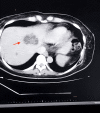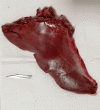Hepatic Glucagonoma in a Post-bariatric Female Patient: A Case Report
- PMID: 38021839
- PMCID: PMC10631158
- DOI: 10.7759/cureus.46724
Hepatic Glucagonoma in a Post-bariatric Female Patient: A Case Report
Abstract
Glucagonomas, neuroendocrine tumors originating from the pancreas marked by excessive glucagon secretion, present a diagnostic challenge due to their rarity and diverse symptomatology. In this report, we present a 47-year-old female with a history of bariatric surgery, diabetes mellitus, and deep vein thrombosis who exhibited weight loss, anemia, migratory necrolytic erythema on the lower limbs and groin, and fecal incontinence. Imaging revealed liver secondary lesions without an identifiable primary tumor. After undergoing surgery, a pathologic examination of the excised tissue confirmed that the lesions were a glucagonoma. This case underscores the imperative of how common side effects of bariatric surgery could mask symptoms, delaying the diagnosis of glucagonomas.
Keywords: diabetes mellitus; general surgery; glucogonoma; necrolytic migratory erythema; neuroendocrine tumor.
Copyright © 2023, Garcia et al.
Conflict of interest statement
The authors have declared that no competing interests exist.
Figures






References
-
- Glucagonoma syndrome: a rare paraneoplastic disorder due to neuroendocrine tumor of the pancreas. Yusuf MA, Mehmood S, Iftikhar J, Saqib M, Siddique MZ, Imtiaz W. J Coll Physicians Surg Pak. 2022;32:0–9. - PubMed
-
- Sandhu S, Jialal I. StatPearls [Internet] Treasure Island (FL): StatPearls Publishing; 2023. Glucagonoma syndrome. - PubMed
-
- Etiology and pathogenesis of necrolytic migratory erythema: review of the literature. Tierney EP, Badger J. https://www.ncbi.nlm.nih.gov/pmc/articles/PMC1435602/ MedGenMed. 2004;6:4. - PMC - PubMed
-
- Glucagonoma syndrome: a review and update on treatment. John AM, Schwartz RA. J Eur Acad Dermatol Venereol. 2016;30:2016–2022. - PubMed
Publication types
LinkOut - more resources
Full Text Sources
